Transporting Worlds through Costume
Roberta Doylend, Vancouver Opera's Head of Wardrobe, discusses the power of textiles
Vancouver Opera presents The Magic Flute - October 21st to 29th, at the Queen Elizabeth Theatre.
Through costuming Roberta Doylend has built cohesive worlds for over 400 shows. Roberta discusses her remarkable career, her role as Vancouver Opera’s Head of Wardrobe, and the visual candy store awaiting audiences in The Magic Flute.
For tickets and more information visit VancouverOpera.ca
You can also download the podcast on all major platforms including Apple Podcasts and Spotify.
Ashley Daniel Foot:
It's Inside Vancouver Opera. My name is Ashley Daniel Foot, and we are talking today with Vancouver Opera's Head of Wardrobe, Roberta Doylend. Roberta has had an amazing career, spanning over 400 productions. Just over a year ago she joined us as head of wardrobe. Roberta told me about why costume is so essential.
Roberta Doylend:
As soon as the performer steps onto that stage, the audience knows who they are, knows where they belong in the world.
Ashley Daniel Foot:
I had a chance to visit a busy costume workshop on the first day of rehearsals for The Magic Flute to talk to her just a little bit about what she does and why she loves it. I hope you enjoy the conversation.
Roberta Doylend:
I think I received the package at some point in the summer from COC, which is Canadian Opera Company. I didn't really have a lot of time this summer to work on it, so I glanced at it and then beginning of September I really took a close look at it.
Ashley Daniel Foot:
When you say package, talk us through what that means. When you know that a show is being programmed or has been selected, what are the first things that you have to do?
Roberta Doylend:
The package that arrives is usually a digital file of all of the costumes that are coming from COC, all of their paperwork, photographs of everything, all of the measurements for the actors. Two weeks to a month in advance, I will start pairing singers up based on their sizes to the costumes we're receiving, hoping I can match everyone. This show came in and Magic Flute at COC was a much larger cast than we have, so that gave me some leeway in costuming for certain people. The principals, definitely, they're set in stone. But this production we're really lucky, they're mostly similar in sizes. But with the chorus members, I was able to find costumes to fit all the chorus members.
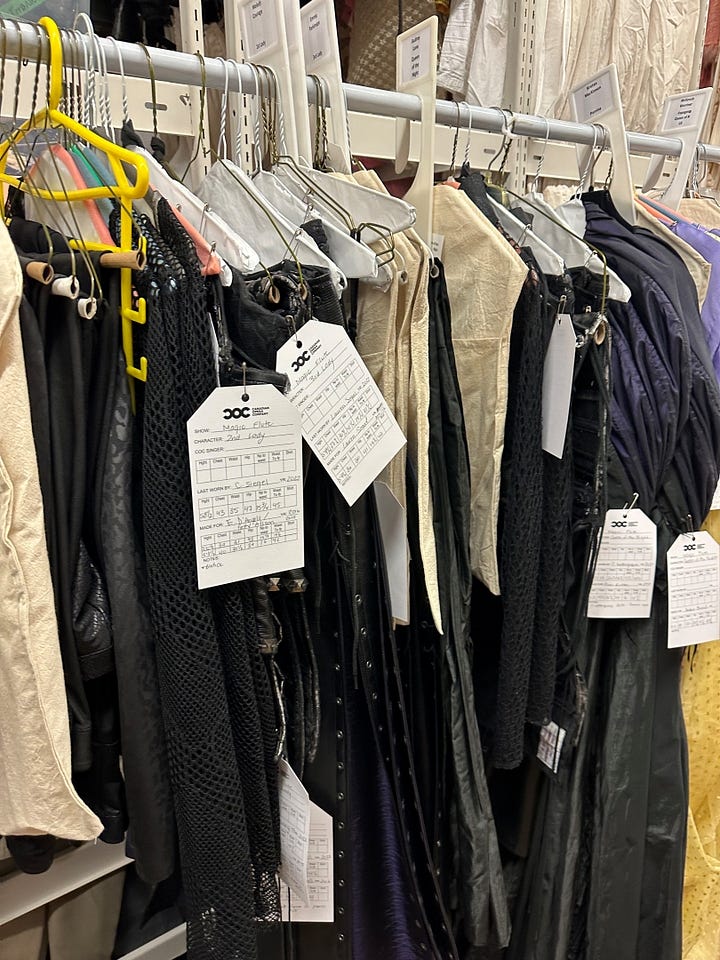

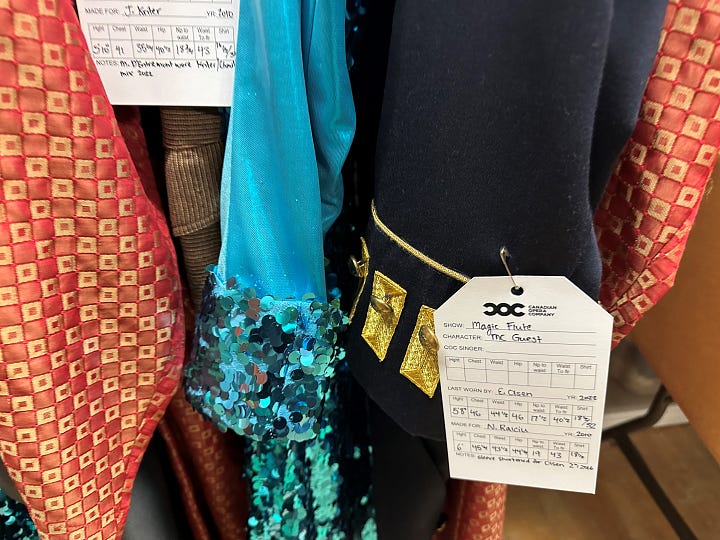

Ashley Daniel Foot:
You have a team of folks that work with you?
Roberta Doylend:
We work in a fairly small team at Vancouver Opera. There's myself and my firsthand is Lily Yuen. She is the head of Wardrobe running at the Queen Elizabeth Theatre as well. It's invaluable having her here, but she also comes with an immense skill-set. Then I have a cutter, Stephanie Kong and one stitcher, her name is Jennifer Reid. She's been with the opera since I started. This team has been together since I started at the opera last September, with Pearl Fishers.
Ashley Daniel Foot:
A year has already gone by.
Roberta Doylend:
I know a year has flown by. So I have Jen and then I have one other stitcher coming in, Kate, who also works at the theatre as well. I get a very select team that are all very knowledgeable people in their field.
Ashley Daniel Foot:
So the process, you received the package, you matched it to what we have. Then, you engage your team because there's probably going to be some major changes, cutting, and things like that.
Roberta Doylend:
I evaluate what comes into us. Once I figured out, okay, sizing is here, I can then look at, okay, what do we need to build? We don't make costumes, we build them. They're very structural theatre costumes, particularly opera costumes are incredibly structural garments.
Ashley Daniel Foot:
Why do you think that is?
Roberta Doylend:
They put in a whole life in a very short period of time, so they have to be incredibly well made. You could wear opera costumes on the street, but they're lined and interlined. They've got little snaps and hooks all over the place to hold them together so the singer can do anything in their costume without being inhibited.
Roberta Doylend:
So they're very structural garments. In this show, we're building three items that don't fit within the stock we have, so we have to build three pieces, which isn't much for an opera.
Ashley Daniel Foot:
Are you working closely with the director in that moment?
Roberta Doylend:
No, I'm replicating items that COC sent. So we're replicating pieces from the original design right down to matching the fabrics and the texture and everything else, so they look like they belong to the show. They don't look any different. We hunt around to find the exact match to the existing.
Ashley Daniel Foot:
A show like this, which is a remount, that's the way you would describe it, is a very different process than a show like Pearl Fishers. Is that fair to say?
Roberta Doylend:
Not really. The Pearl Fishers was also a rental. It came from Santa Fe Opera. I didn't get any pre-time with Pearl Fishers. It was a show, it rented, and it got stuck in customs, and it showed up a week and a half late.
Roberta Doylend:
We opened the boxes up, all of us going, "Okay, we're going to make it work." And we were able to make it work. Plus there was in Pearl Fishers, there was another element of design that was implemented, which I took over and I ended up designing that element. There was two, there was the preamble of Western costume on several of the principals, and then the social commentary with the Sri Lankan dancers, which was absolutely lovely to work with. The women who came because they came with their culture and shared their culture with me in order for me to create a modern take on their traditional dance garments.
Ashley Daniel Foot:
Then you designed A Midsummer Night's Dream costumes.
Roberta Doylend:
I designed Midsummer Night's Dream costumes.
Ashley Daniel Foot:
I think what I'm asking is if you can talk to our listeners about the key differences, aside from it being a remount and a design, what does the process look like for you there?
Roberta Doylend:
As a designer? It begins with the discussion, many discussions with the director on what their artistic vision is. I had many discussions with the director. I would do a number of images up for her sketches, renderings. I collaged a lot. I did a lot of written descriptions of what I wanted to achieve because it was a fairly tight timeline. You gain a trust as artistic colleagues, and then it was like, "Here is everything. We are going to make it happen." It was a lot of building and a lot cooperative... we were all stitching. As a head of wardrobe, I'm able to.. I am a cutter, I'm a tailor, and I stitch so I can pop in and help with everything.
Ashley Daniel Foot:
So you can do it all; you have done this for a while.
Roberta Doylend:
I have done this for many years.
Ashley Daniel Foot:
How did this become something that you knew that you wanted to do and become your vocation?
Roberta Doylend:
I have always sewn. I started sewing was when I was about three years of age. My mother could not keep me away from my sewing machine.
Ashley Daniel Foot:
Really?
Roberta Doylend:
Barbie dolls, boring. I'd rather dress people. It's funny because I didn't go to university initially to become a costume designer. I wasn't in theatre. I was doing an undergrad to go into law school.
Ashley Daniel Foot:
No kidding!
Roberta Doylend:
I was going to be a lawyer.
Ashley Daniel Foot:
Where was this?
Roberta Doylend:
At UVic, University of Victoria. I got partway through my degree and went, "This isn't working." I started sewing for people and I met somebody, and I went and worked at Expo '86. I'm dating myself now. It was just like a whole new world opened up to me.
I had a blast and it was just like, "This is what I'm meant to do." I went back to university. I worked for a few years in Vancouver. I lived and worked in Vancouver, worked for a costume company, and then I went, I need to go to school and get a degree in this. I went back to UVic and got my degree and have not stopped designing. My degree is Bachelor of Fine Arts in Focus on Design, but I have run shops over the years. I also design and build and I've got over 400 shows to my credit.
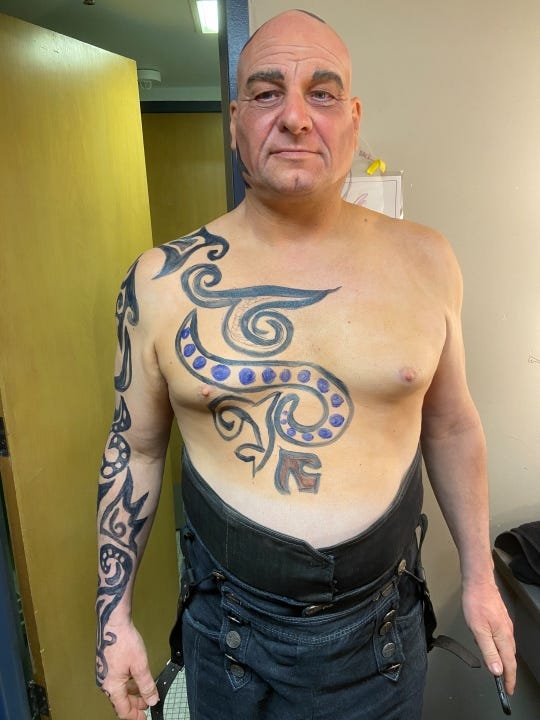
Ashley Daniel Foot:
400 shows! They must all blend together sometimes.
Roberta Doylend:
No, and I run into people I haven't seen in 30 years and it's like, "Hi, how are you? I still know your sizes." Then a number of years ago I got enticed to move to Ontario and I was the head of wardrobe at Brock University for 14 years.
Ashley Daniel Foot:
How'd you come back to Vancouver?
Roberta Doylend:
I was ready to retire. I came back to the West Coast, moved back to the West Coast last July. Within five weeks of arriving here, Nicole Lamb called me up and said, "Hi, I hear you're on the West Coast. Would you be interested in…" I went, "Sure, I'll do Pearl Fishers." Now it's a year later and we're working on Magic Flute, and I love it.
Ashley Daniel Foot:
Why is costume design and costuming so important to the theatrical/artistic journey?
Roberta Doylend:
A costume design is integral because as soon as the performer steps onto that stage, the audience knows who they are, knows where they belong in the world, and can gain character without even the performer opening their mouth. It's that visual connection to the play. Then when all actors and all performers are on stage and in the performance and you're as an audience looking at this as a whole, it becomes a cohesive world that is separate from the world you live in. Wardrobe supports the performer into becoming that character. Without it, you can tell. You go see theatre without costume, you go see theatre without a set design, and you can tell. Costume, particularly for me, transports the audience to that world.
Ashley Daniel Foot:
What do you think an audience member should know when they're coming to Magic Flute about the idiosyncrasies of this show? Is there anything we should be looking out for?
Roberta Doylend:
No. Sit back, take it in. Open your eyes, your ears. The visuals of this production are stunning. The music is… sublime. It really is. It's one of my favourite operas. It's a visual candy store. It really is. The costumes for this production are gorgeous. The set is lovely, and we know the voices are gorgeous. I can't wait to sit down in rehearsal and listen to them sing.
Ashley Daniel Foot:
Costumes, my goodness, what a thing. Thanks Roberta for a great conversation and I hope you enjoyed the insight into what I think is a really fascinating and essential aspect to our production process. Stay tuned for our next check-in with Vancouver Opera's head of properties, Steven Elgar. I'll see you at the opera.
CREDITS
Host - Ashley Daniel Foot
Guest - Roberta Doylend
Editor - Mack McGillivray






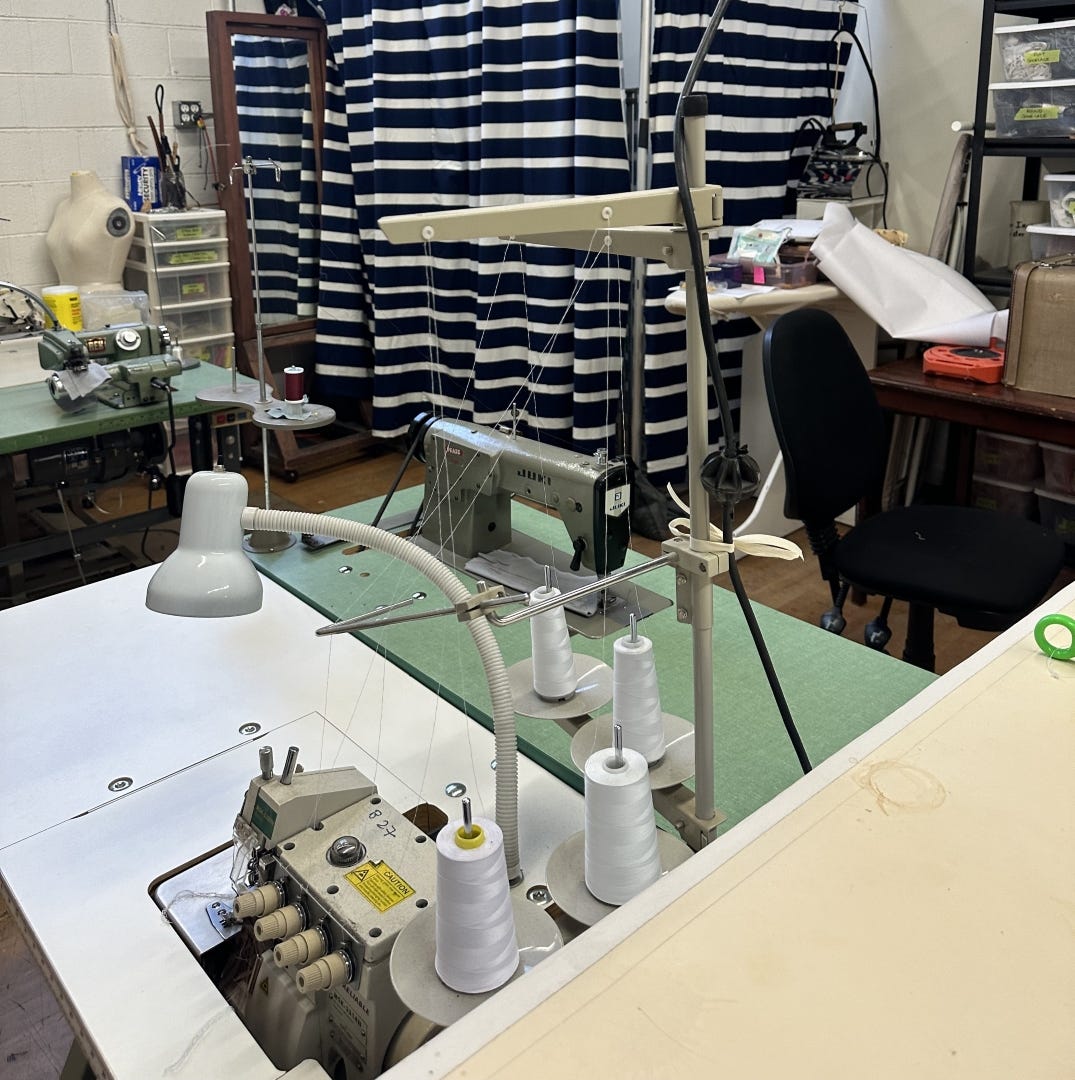



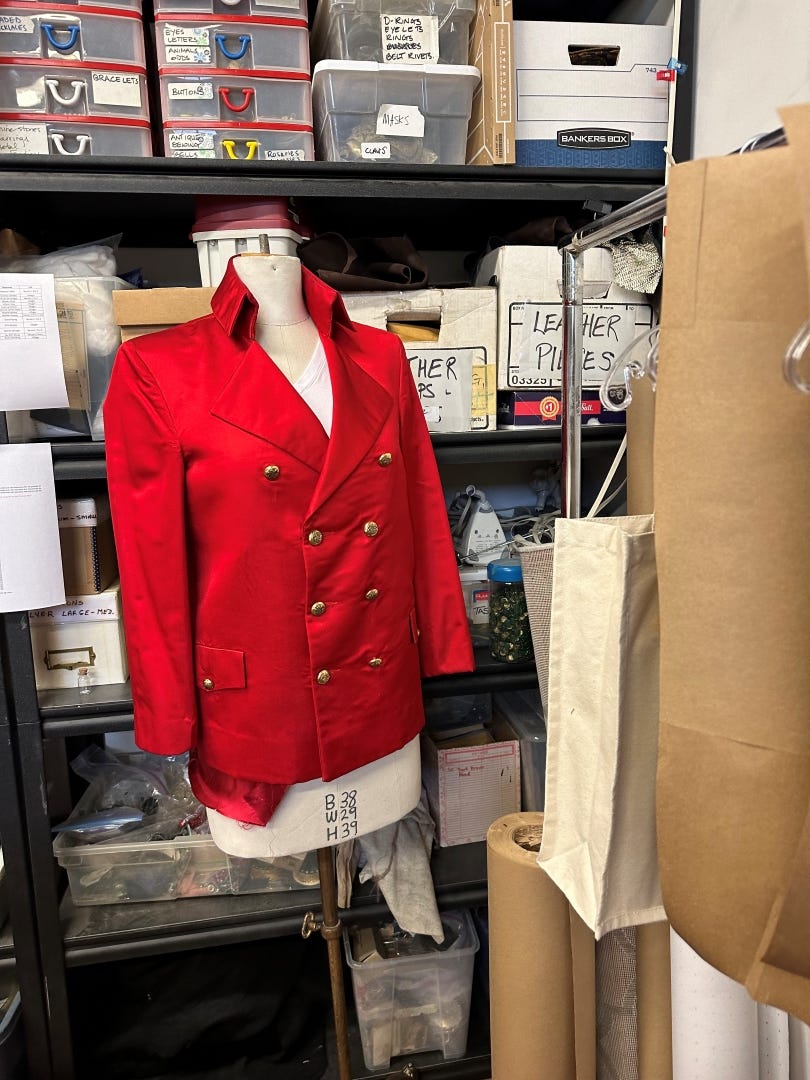
Such a tremendous amount of work! Where do all the materials come from?